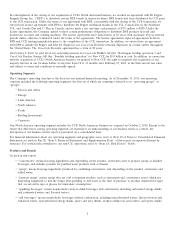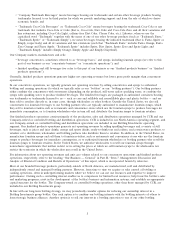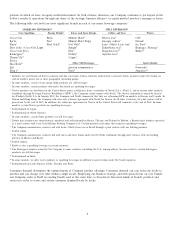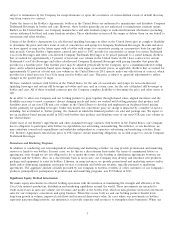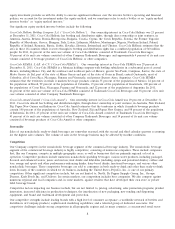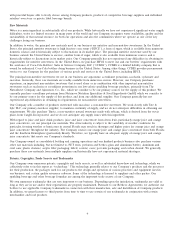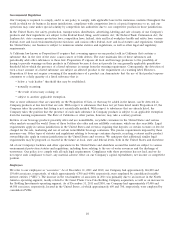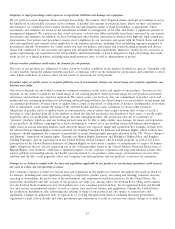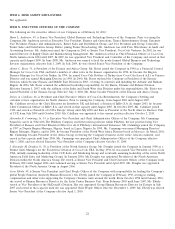Coca Cola 2011 Annual Report Download - page 14
Download and view the complete annual report
Please find page 14 of the 2011 Coca Cola annual report below. You can navigate through the pages in the report by either clicking on the pages listed below, or by using the keyword search tool below to find specific information within the annual report.acquisition, we believed that the transaction would, among other things, enhance our ability to create a more fully integrated and
adaptable supply chain in the North American market to allow our combined North American business to more efficiently and
effectively operate our distribution chain in the North American territories and enhance revenue opportunities; create a unified
operating system in North America that will address the unique needs of the North American market; strategically position us to
better market and distribute our products in North America; improve efficiencies by streamlining operations and reducing or
eliminating the costs, expenses, management time and resources associated with interactions and negotiations between the
previously separate organizations; allow us to optimize and improve the efficiencies of manufacturing and logistics operations in
North America through economies of scale and geography; generate significant operational synergies; facilitate and increase the
pace of innovation and new product introduction in North America; and optimize our operating model and improve the strategic
planning process, increasing management focus and streamlining decision making. While we believe that the anticipated benefits
of the acquisition are achievable, it is possible that we may not be able to realize some or even a significant portion of such
benefits, or may not be able to achieve them within the anticipated time frame. If we are unable to realize a significant portion of
the anticipated benefits, or if it takes us significantly longer than expected to realize such benefits, our future results of operations
may be adversely affected and we may not be able to meet investors’ expectations or achieve our long-term growth objectives,
which could negatively affect the value of your investment in our Company.
Our indebtedness increased significantly as a result of the acquisition of CCE’s North American business. Our higher level of
indebtedness will increase our borrowing costs and interest expense in future periods and, therefore, may adversely affect our financial
performance.
As a result of the CCE transaction, we assumed $7.9 billion of debt from CCE. Our increased level of indebtedness and resulting
higher borrowing costs and interest expense may reduce amounts available for dividends, stock repurchases, capital expenditures
and acquisitions, and may cause rating agencies to downgrade our debt, all of which could have adverse effects on our future
financial performance.
Our pension expense increased substantially as a result of the acquisition of CCE’s North American business and we may incur multi-
employer plan withdrawal liabilities in the future, which could negatively impact our financial performance.
Our total pension expense for 2011 was $249 million compared with $176 million for 2010. Most of the pension expense increase
in 2011 was due to the full year impact of our acquisition of CCE’s North American business and a decrease in the Company’s
discount rate compared to 2010. In addition, the Company’s expense for U.S. multi-employer pension plans totaled $69 million in
2011, of which $32 million was related to our withdrawal from certain of these plans. The U.S. multi-employer pension plans in
which we currently participate have contractual arrangements that extend into 2017. If, in the future, we choose to withdraw from
any of the multi-employer pension plans in which we participate, we will likely need to record withdrawal liabilities which could
negatively impact our financial performance in the applicable periods.
Continuing uncertainty in the credit and equity markets may adversely affect our financial performance.
The global credit markets experienced unprecedented disruptions during late 2008 and early 2009. While credit market conditions
have improved somewhat since the crisis, the improvements have not been uniform. In addition, the sovereign debt crisis affecting
various countries in the European Union is creating further uncertainties in the global credit markets. The cost and availability of
credit vary by market and are subject to changes in the global or regional economic environment. If the current uncertain
conditions in the credit markets continue or worsen, our ability to access credit markets on favorable terms may be negatively
affected, which could increase our cost of borrowing. In addition, the current uncertain credit market conditions may make it
more difficult for our bottling partners to access financing on terms comparable to those available prior to the global credit crisis,
which would affect the Coca-Cola system’s profitability as well as our share of the income of bottling partners in which we have
equity method investments. The current uncertain global credit market conditions and their actual or perceived effects on our and
our major bottling partners’ results of operations and financial condition, along with the current unfavorable economic
environment in the United States and much of the world, may increase the likelihood that the major independent credit agencies
will downgrade our credit ratings, which could have a negative effect on our borrowing costs.
In addition, some of the major financial institutions remain fragile, and the counterparty risk associated with our existing
derivative financial instruments remains higher than pre-crisis levels. Therefore, we may be unable to secure creditworthy
counterparties for derivative transactions in the future or may incur higher than anticipated costs in our hedging activities. The
decrease in availability of consumer credit resulting from the financial crisis, as well as general unfavorable economic conditions,
may also cause consumers to reduce their discretionary spending, which would reduce the demand for our beverages and
negatively affect our net operating revenues and the Coca-Cola system’s profitability.
12


